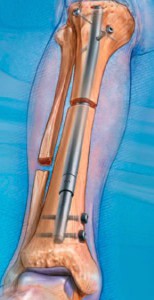Allungamento con chiodo endomidollare Stryde o Precice I/II
L’allungamento degli arti, sia a livello del femore, della tibia o dell’omero per l’arto superiore, avviene tramite piccole incisioni attraverso le quali viene inserito il chiodo endomidollare.
Questo chiodo è posizionato nel segmento osseo da allungare e, dopo un’osteotomia, viene fissato con viti sia prossimali che distali.
Dopo qualche giorno, si inizia ad allungare l’arto 2-3 volte al giorno, controllando la quantità di allungamento tramite un motore magnetico all’interno del chiodo, il quale è comandato esternamente. Una volta raggiunto l’allungamento programmato, il chiodo si ferma automaticamente. La precisione di questa procedura è estremamente elevata.
Tale procedura è ben tollerata dai pazienti, ma possono comunque sorgere problemi di contrattura muscolare. Inoltre, è importante considerare l’alto costo dei chiodi e la necessità di rimuoverli una volta completato il trattamento e avvenuta la consolidazione. In rari casi, circa il 5%, un chiodo tibiale può causare una sintomatologia dolorosa al tendine rotuleo, secondo l’esperienza di molti.”
Chiodo Stryde per allungamento estetico

Leg Lengthening with intramedullary (internal) nail Stryde – Precice I/II
The nail is inserted in the leg (femur or tibia) and after the osteotomy (cut of the bone) it is fixed proximally and distally with screws. To start the lengthening the nail uses a magnetic mechanism driven from outside by the patient.
This method is quite comfortable for the patients. There are no external devices. Muscular contractures are still possible as for all other techniques. The operation is longer, there is a considerable blood loss, even thought transfusions are quite unlikely , and carries a small risk of fat embolism.
At the end of the treatment, when a solid consolidation of the new bone is achieved the nail is removed.
During this time it is possible to walk with a walker or crutches.
Down points
Lengthening the tibia with a nail is often associated with permanent anterior knee pain 2-4% risk.
This method is more expensive (2 or 3 times the cost of an external fixator HEF) due to the high cost of the nails.
Stryde nail

Possible risks of this procedure:
- Wound and bone infection
- Delayed bone consolidation needing a second procedure such as bone grafting
- Deformities needing further surgery
- Metalwork fatigue and break
- Fracture during the surgery.
- Muscles contractures (Achilles Tendon Lengthening might be required in Tibia lengthening)
- Neurovascular problems due to blood vassels or nerve stretching. This complication have never been experienced by our patients but are described in the literature.
